An Analysis of Social, Economic, and Cultural Health Determinants
VerifiedAdded on 2021/04/24
|8
|2114
|35
Essay
AI Summary
This essay examines the intricate relationship between social, economic, and cultural determinants and their profound impact on health outcomes, particularly in the context of the epidemiological transition from infectious diseases to chronic conditions. The essay highlights how socioeconomic status influences lifestyle choices, access to healthcare, and overall health, with a focus on the increased vulnerability of individuals from lower socioeconomic strata to chronic diseases like diabetes, hypertension, and cardiovascular diseases. It explores the role of cultural factors, such as ethnicity and religion, in shaping health behaviors and outcomes. The essay references several studies that demonstrate how factors like education, income, and social support affect health inequalities. It emphasizes the importance of public health initiatives in addressing these disparities by educating and empowering vulnerable populations to make healthier choices and improve their overall well-being. The essay concludes by reiterating the need for targeted interventions to mitigate the adverse effects of social and economic disadvantages on health, especially in the wake of the ongoing shift from infectious to chronic diseases.

Health Science
Name
University
Name
University
Paraphrase This Document
Need a fresh take? Get an instant paraphrase of this document with our AI Paraphraser
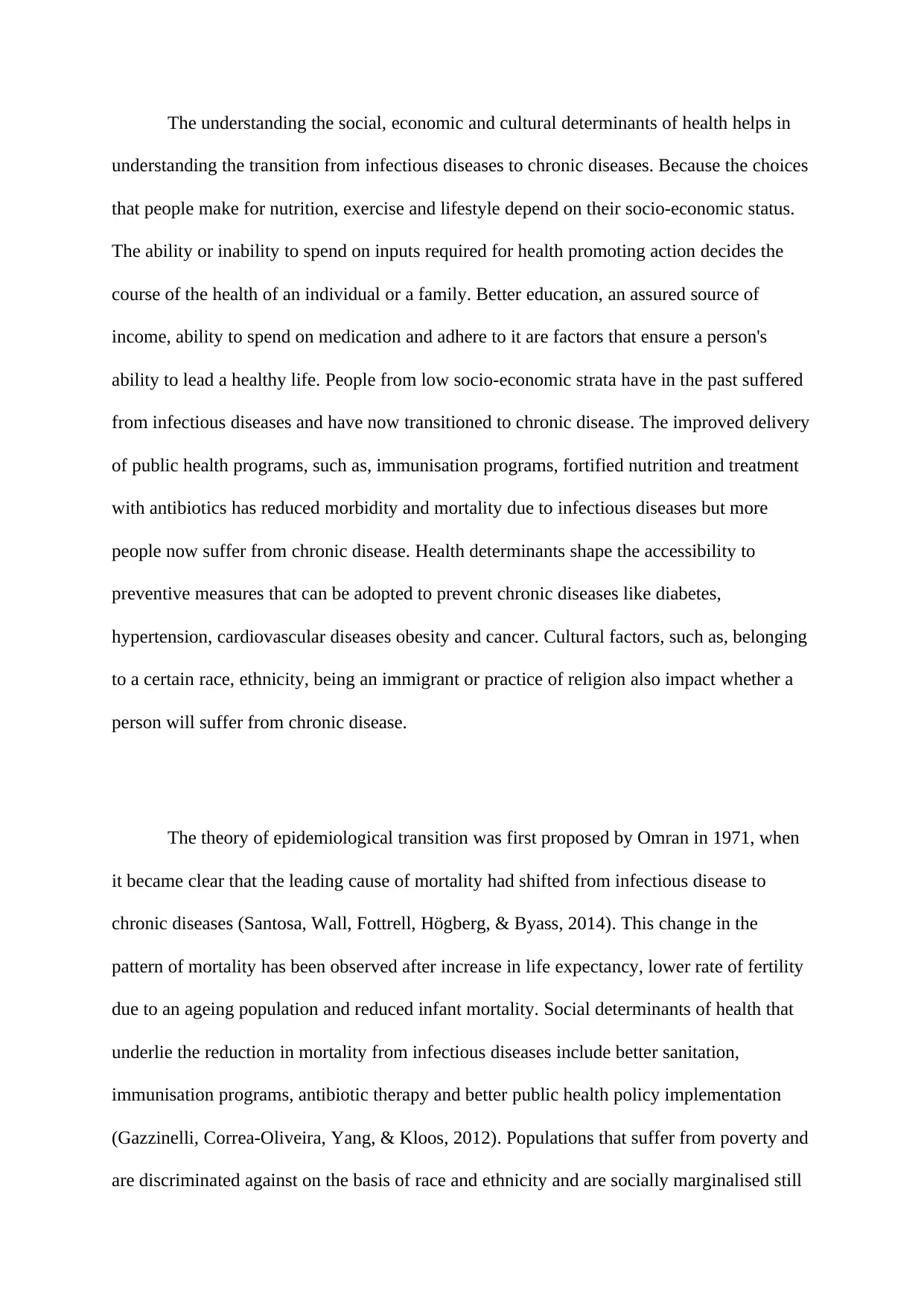
The understanding the social, economic and cultural determinants of health helps in
understanding the transition from infectious diseases to chronic diseases. Because the choices
that people make for nutrition, exercise and lifestyle depend on their socio-economic status.
The ability or inability to spend on inputs required for health promoting action decides the
course of the health of an individual or a family. Better education, an assured source of
income, ability to spend on medication and adhere to it are factors that ensure a person's
ability to lead a healthy life. People from low socio-economic strata have in the past suffered
from infectious diseases and have now transitioned to chronic disease. The improved delivery
of public health programs, such as, immunisation programs, fortified nutrition and treatment
with antibiotics has reduced morbidity and mortality due to infectious diseases but more
people now suffer from chronic disease. Health determinants shape the accessibility to
preventive measures that can be adopted to prevent chronic diseases like diabetes,
hypertension, cardiovascular diseases obesity and cancer. Cultural factors, such as, belonging
to a certain race, ethnicity, being an immigrant or practice of religion also impact whether a
person will suffer from chronic disease.
The theory of epidemiological transition was first proposed by Omran in 1971, when
it became clear that the leading cause of mortality had shifted from infectious disease to
chronic diseases (Santosa, Wall, Fottrell, Högberg, & Byass, 2014). This change in the
pattern of mortality has been observed after increase in life expectancy, lower rate of fertility
due to an ageing population and reduced infant mortality. Social determinants of health that
underlie the reduction in mortality from infectious diseases include better sanitation,
immunisation programs, antibiotic therapy and better public health policy implementation
(Gazzinelli, Correa-Oliveira, Yang, & Kloos, 2012). Populations that suffer from poverty and
are discriminated against on the basis of race and ethnicity and are socially marginalised still
understanding the transition from infectious diseases to chronic diseases. Because the choices
that people make for nutrition, exercise and lifestyle depend on their socio-economic status.
The ability or inability to spend on inputs required for health promoting action decides the
course of the health of an individual or a family. Better education, an assured source of
income, ability to spend on medication and adhere to it are factors that ensure a person's
ability to lead a healthy life. People from low socio-economic strata have in the past suffered
from infectious diseases and have now transitioned to chronic disease. The improved delivery
of public health programs, such as, immunisation programs, fortified nutrition and treatment
with antibiotics has reduced morbidity and mortality due to infectious diseases but more
people now suffer from chronic disease. Health determinants shape the accessibility to
preventive measures that can be adopted to prevent chronic diseases like diabetes,
hypertension, cardiovascular diseases obesity and cancer. Cultural factors, such as, belonging
to a certain race, ethnicity, being an immigrant or practice of religion also impact whether a
person will suffer from chronic disease.
The theory of epidemiological transition was first proposed by Omran in 1971, when
it became clear that the leading cause of mortality had shifted from infectious disease to
chronic diseases (Santosa, Wall, Fottrell, Högberg, & Byass, 2014). This change in the
pattern of mortality has been observed after increase in life expectancy, lower rate of fertility
due to an ageing population and reduced infant mortality. Social determinants of health that
underlie the reduction in mortality from infectious diseases include better sanitation,
immunisation programs, antibiotic therapy and better public health policy implementation
(Gazzinelli, Correa-Oliveira, Yang, & Kloos, 2012). Populations that suffer from poverty and
are discriminated against on the basis of race and ethnicity and are socially marginalised still
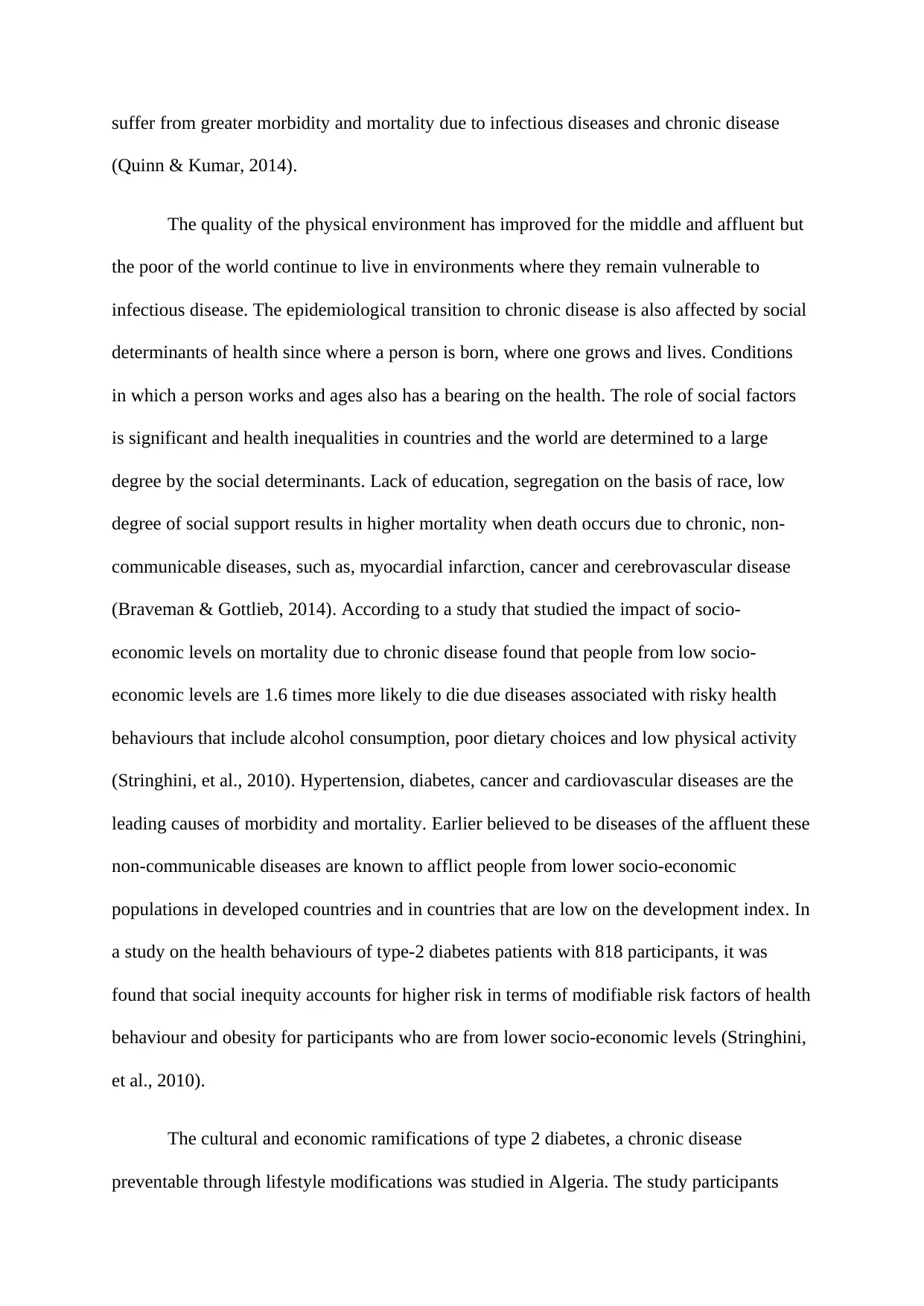
suffer from greater morbidity and mortality due to infectious diseases and chronic disease
(Quinn & Kumar, 2014).
The quality of the physical environment has improved for the middle and affluent but
the poor of the world continue to live in environments where they remain vulnerable to
infectious disease. The epidemiological transition to chronic disease is also affected by social
determinants of health since where a person is born, where one grows and lives. Conditions
in which a person works and ages also has a bearing on the health. The role of social factors
is significant and health inequalities in countries and the world are determined to a large
degree by the social determinants. Lack of education, segregation on the basis of race, low
degree of social support results in higher mortality when death occurs due to chronic, non-
communicable diseases, such as, myocardial infarction, cancer and cerebrovascular disease
(Braveman & Gottlieb, 2014). According to a study that studied the impact of socio-
economic levels on mortality due to chronic disease found that people from low socio-
economic levels are 1.6 times more likely to die due diseases associated with risky health
behaviours that include alcohol consumption, poor dietary choices and low physical activity
(Stringhini, et al., 2010). Hypertension, diabetes, cancer and cardiovascular diseases are the
leading causes of morbidity and mortality. Earlier believed to be diseases of the affluent these
non-communicable diseases are known to afflict people from lower socio-economic
populations in developed countries and in countries that are low on the development index. In
a study on the health behaviours of type-2 diabetes patients with 818 participants, it was
found that social inequity accounts for higher risk in terms of modifiable risk factors of health
behaviour and obesity for participants who are from lower socio-economic levels (Stringhini,
et al., 2010).
The cultural and economic ramifications of type 2 diabetes, a chronic disease
preventable through lifestyle modifications was studied in Algeria. The study participants
(Quinn & Kumar, 2014).
The quality of the physical environment has improved for the middle and affluent but
the poor of the world continue to live in environments where they remain vulnerable to
infectious disease. The epidemiological transition to chronic disease is also affected by social
determinants of health since where a person is born, where one grows and lives. Conditions
in which a person works and ages also has a bearing on the health. The role of social factors
is significant and health inequalities in countries and the world are determined to a large
degree by the social determinants. Lack of education, segregation on the basis of race, low
degree of social support results in higher mortality when death occurs due to chronic, non-
communicable diseases, such as, myocardial infarction, cancer and cerebrovascular disease
(Braveman & Gottlieb, 2014). According to a study that studied the impact of socio-
economic levels on mortality due to chronic disease found that people from low socio-
economic levels are 1.6 times more likely to die due diseases associated with risky health
behaviours that include alcohol consumption, poor dietary choices and low physical activity
(Stringhini, et al., 2010). Hypertension, diabetes, cancer and cardiovascular diseases are the
leading causes of morbidity and mortality. Earlier believed to be diseases of the affluent these
non-communicable diseases are known to afflict people from lower socio-economic
populations in developed countries and in countries that are low on the development index. In
a study on the health behaviours of type-2 diabetes patients with 818 participants, it was
found that social inequity accounts for higher risk in terms of modifiable risk factors of health
behaviour and obesity for participants who are from lower socio-economic levels (Stringhini,
et al., 2010).
The cultural and economic ramifications of type 2 diabetes, a chronic disease
preventable through lifestyle modifications was studied in Algeria. The study participants
⊘ This is a preview!⊘
Do you want full access?
Subscribe today to unlock all pages.

Trusted by 1+ million students worldwide
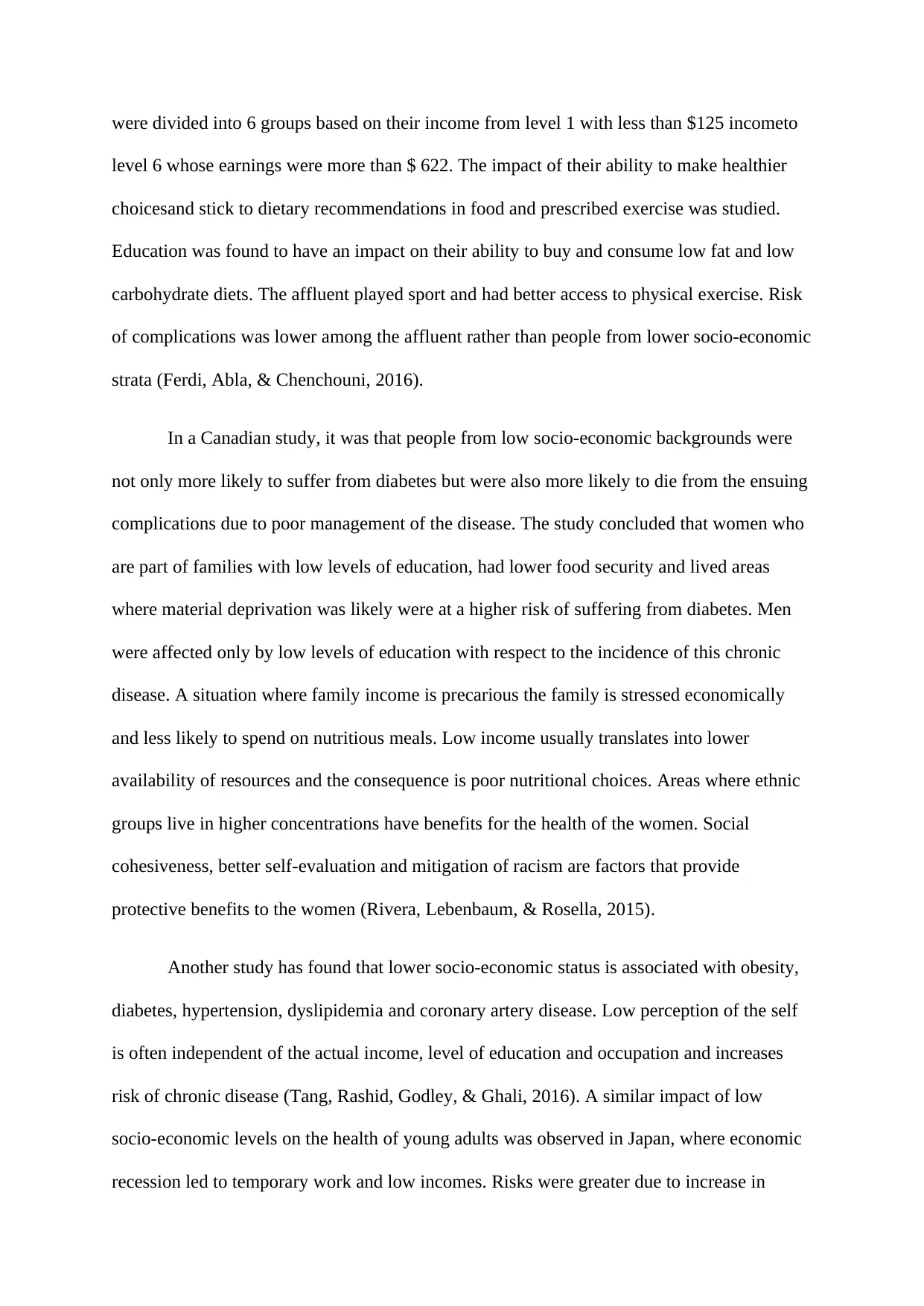
were divided into 6 groups based on their income from level 1 with less than $125 incometo
level 6 whose earnings were more than $ 622. The impact of their ability to make healthier
choicesand stick to dietary recommendations in food and prescribed exercise was studied.
Education was found to have an impact on their ability to buy and consume low fat and low
carbohydrate diets. The affluent played sport and had better access to physical exercise. Risk
of complications was lower among the affluent rather than people from lower socio-economic
strata (Ferdi, Abla, & Chenchouni, 2016).
In a Canadian study, it was that people from low socio-economic backgrounds were
not only more likely to suffer from diabetes but were also more likely to die from the ensuing
complications due to poor management of the disease. The study concluded that women who
are part of families with low levels of education, had lower food security and lived areas
where material deprivation was likely were at a higher risk of suffering from diabetes. Men
were affected only by low levels of education with respect to the incidence of this chronic
disease. A situation where family income is precarious the family is stressed economically
and less likely to spend on nutritious meals. Low income usually translates into lower
availability of resources and the consequence is poor nutritional choices. Areas where ethnic
groups live in higher concentrations have benefits for the health of the women. Social
cohesiveness, better self-evaluation and mitigation of racism are factors that provide
protective benefits to the women (Rivera, Lebenbaum, & Rosella, 2015).
Another study has found that lower socio-economic status is associated with obesity,
diabetes, hypertension, dyslipidemia and coronary artery disease. Low perception of the self
is often independent of the actual income, level of education and occupation and increases
risk of chronic disease (Tang, Rashid, Godley, & Ghali, 2016). A similar impact of low
socio-economic levels on the health of young adults was observed in Japan, where economic
recession led to temporary work and low incomes. Risks were greater due to increase in
level 6 whose earnings were more than $ 622. The impact of their ability to make healthier
choicesand stick to dietary recommendations in food and prescribed exercise was studied.
Education was found to have an impact on their ability to buy and consume low fat and low
carbohydrate diets. The affluent played sport and had better access to physical exercise. Risk
of complications was lower among the affluent rather than people from lower socio-economic
strata (Ferdi, Abla, & Chenchouni, 2016).
In a Canadian study, it was that people from low socio-economic backgrounds were
not only more likely to suffer from diabetes but were also more likely to die from the ensuing
complications due to poor management of the disease. The study concluded that women who
are part of families with low levels of education, had lower food security and lived areas
where material deprivation was likely were at a higher risk of suffering from diabetes. Men
were affected only by low levels of education with respect to the incidence of this chronic
disease. A situation where family income is precarious the family is stressed economically
and less likely to spend on nutritious meals. Low income usually translates into lower
availability of resources and the consequence is poor nutritional choices. Areas where ethnic
groups live in higher concentrations have benefits for the health of the women. Social
cohesiveness, better self-evaluation and mitigation of racism are factors that provide
protective benefits to the women (Rivera, Lebenbaum, & Rosella, 2015).
Another study has found that lower socio-economic status is associated with obesity,
diabetes, hypertension, dyslipidemia and coronary artery disease. Low perception of the self
is often independent of the actual income, level of education and occupation and increases
risk of chronic disease (Tang, Rashid, Godley, & Ghali, 2016). A similar impact of low
socio-economic levels on the health of young adults was observed in Japan, where economic
recession led to temporary work and low incomes. Risks were greater due to increase in
Paraphrase This Document
Need a fresh take? Get an instant paraphrase of this document with our AI Paraphraser
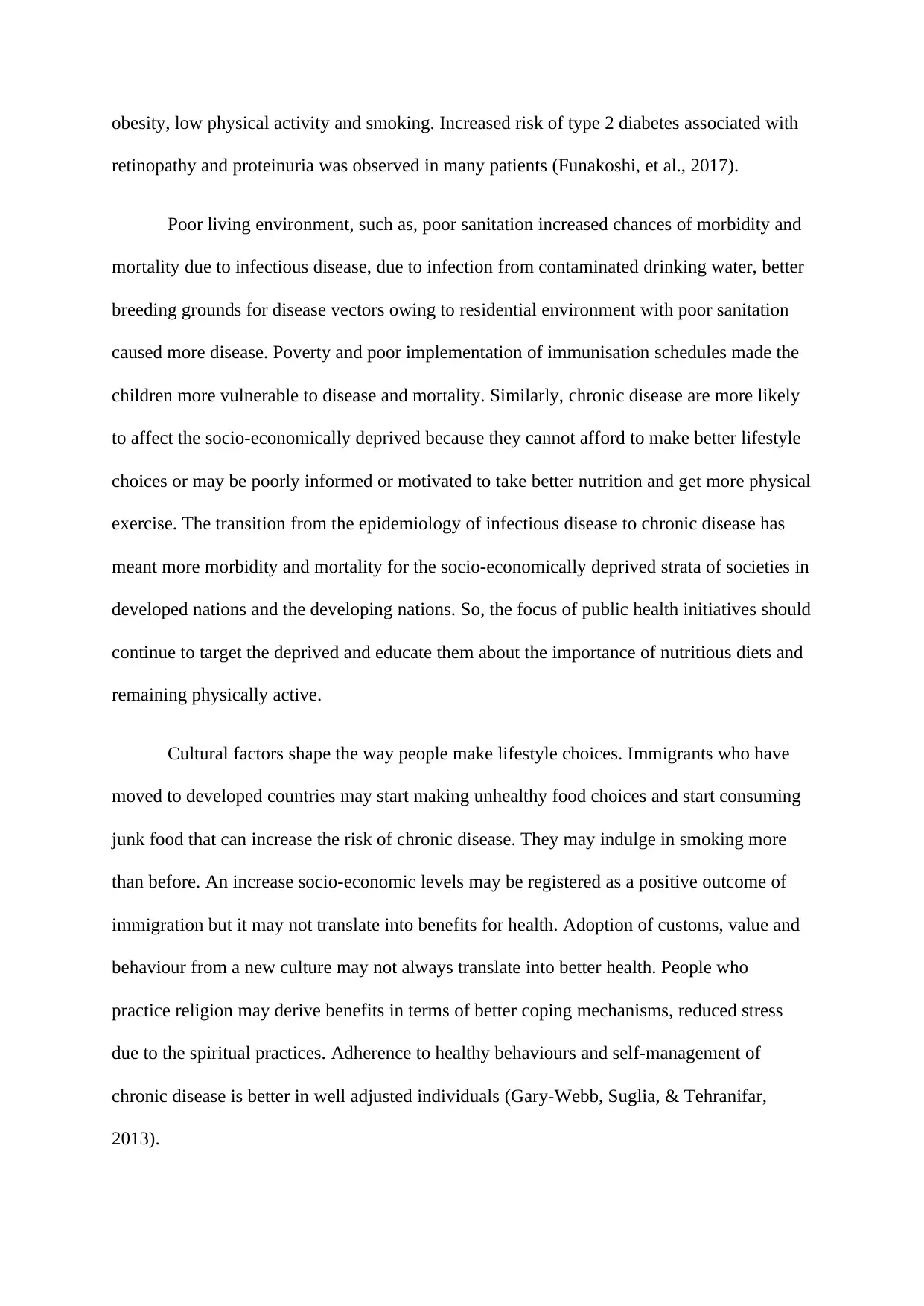
obesity, low physical activity and smoking. Increased risk of type 2 diabetes associated with
retinopathy and proteinuria was observed in many patients (Funakoshi, et al., 2017).
Poor living environment, such as, poor sanitation increased chances of morbidity and
mortality due to infectious disease, due to infection from contaminated drinking water, better
breeding grounds for disease vectors owing to residential environment with poor sanitation
caused more disease. Poverty and poor implementation of immunisation schedules made the
children more vulnerable to disease and mortality. Similarly, chronic disease are more likely
to affect the socio-economically deprived because they cannot afford to make better lifestyle
choices or may be poorly informed or motivated to take better nutrition and get more physical
exercise. The transition from the epidemiology of infectious disease to chronic disease has
meant more morbidity and mortality for the socio-economically deprived strata of societies in
developed nations and the developing nations. So, the focus of public health initiatives should
continue to target the deprived and educate them about the importance of nutritious diets and
remaining physically active.
Cultural factors shape the way people make lifestyle choices. Immigrants who have
moved to developed countries may start making unhealthy food choices and start consuming
junk food that can increase the risk of chronic disease. They may indulge in smoking more
than before. An increase socio-economic levels may be registered as a positive outcome of
immigration but it may not translate into benefits for health. Adoption of customs, value and
behaviour from a new culture may not always translate into better health. People who
practice religion may derive benefits in terms of better coping mechanisms, reduced stress
due to the spiritual practices. Adherence to healthy behaviours and self-management of
chronic disease is better in well adjusted individuals (Gary-Webb, Suglia, & Tehranifar,
2013).
retinopathy and proteinuria was observed in many patients (Funakoshi, et al., 2017).
Poor living environment, such as, poor sanitation increased chances of morbidity and
mortality due to infectious disease, due to infection from contaminated drinking water, better
breeding grounds for disease vectors owing to residential environment with poor sanitation
caused more disease. Poverty and poor implementation of immunisation schedules made the
children more vulnerable to disease and mortality. Similarly, chronic disease are more likely
to affect the socio-economically deprived because they cannot afford to make better lifestyle
choices or may be poorly informed or motivated to take better nutrition and get more physical
exercise. The transition from the epidemiology of infectious disease to chronic disease has
meant more morbidity and mortality for the socio-economically deprived strata of societies in
developed nations and the developing nations. So, the focus of public health initiatives should
continue to target the deprived and educate them about the importance of nutritious diets and
remaining physically active.
Cultural factors shape the way people make lifestyle choices. Immigrants who have
moved to developed countries may start making unhealthy food choices and start consuming
junk food that can increase the risk of chronic disease. They may indulge in smoking more
than before. An increase socio-economic levels may be registered as a positive outcome of
immigration but it may not translate into benefits for health. Adoption of customs, value and
behaviour from a new culture may not always translate into better health. People who
practice religion may derive benefits in terms of better coping mechanisms, reduced stress
due to the spiritual practices. Adherence to healthy behaviours and self-management of
chronic disease is better in well adjusted individuals (Gary-Webb, Suglia, & Tehranifar,
2013).
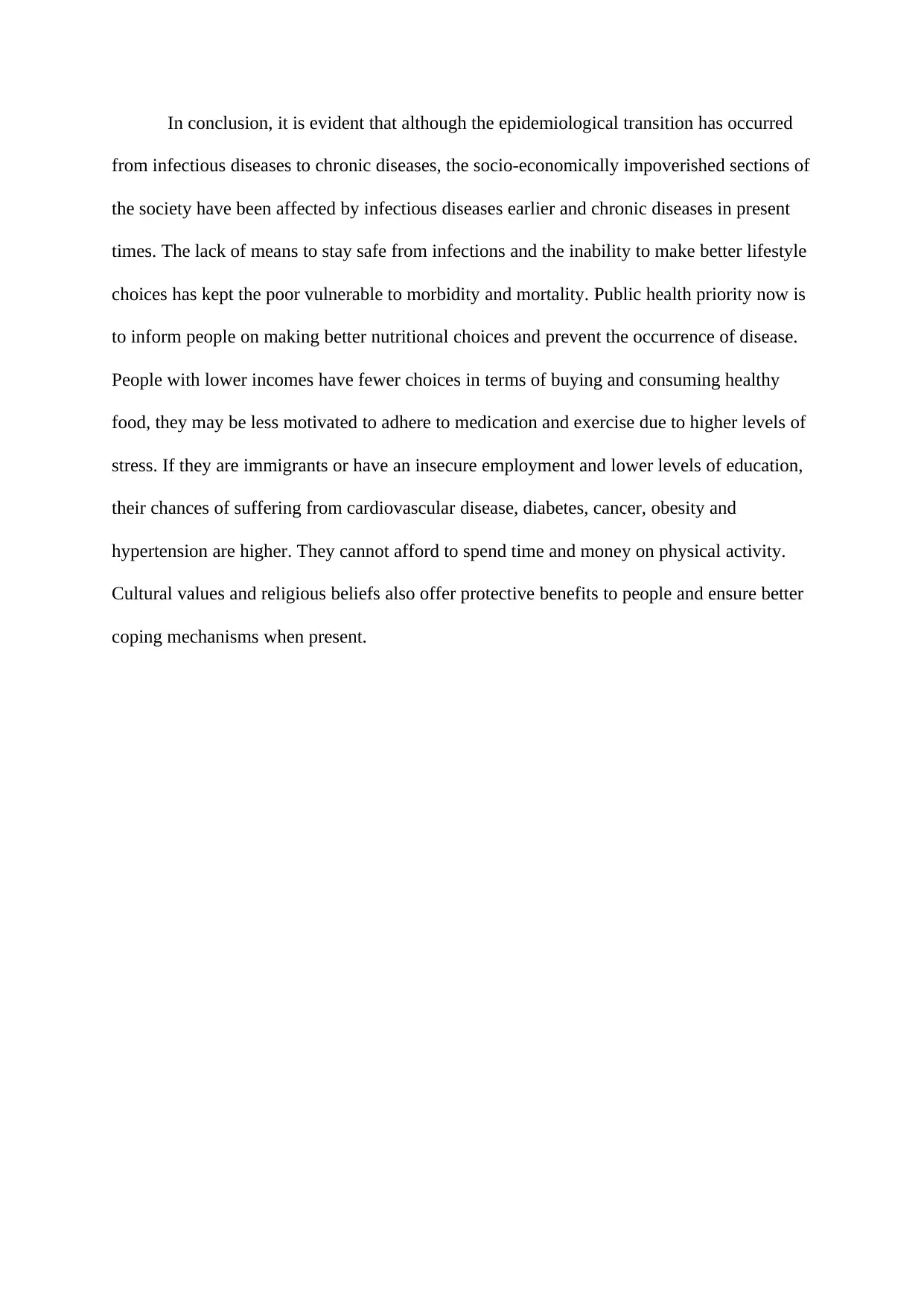
In conclusion, it is evident that although the epidemiological transition has occurred
from infectious diseases to chronic diseases, the socio-economically impoverished sections of
the society have been affected by infectious diseases earlier and chronic diseases in present
times. The lack of means to stay safe from infections and the inability to make better lifestyle
choices has kept the poor vulnerable to morbidity and mortality. Public health priority now is
to inform people on making better nutritional choices and prevent the occurrence of disease.
People with lower incomes have fewer choices in terms of buying and consuming healthy
food, they may be less motivated to adhere to medication and exercise due to higher levels of
stress. If they are immigrants or have an insecure employment and lower levels of education,
their chances of suffering from cardiovascular disease, diabetes, cancer, obesity and
hypertension are higher. They cannot afford to spend time and money on physical activity.
Cultural values and religious beliefs also offer protective benefits to people and ensure better
coping mechanisms when present.
from infectious diseases to chronic diseases, the socio-economically impoverished sections of
the society have been affected by infectious diseases earlier and chronic diseases in present
times. The lack of means to stay safe from infections and the inability to make better lifestyle
choices has kept the poor vulnerable to morbidity and mortality. Public health priority now is
to inform people on making better nutritional choices and prevent the occurrence of disease.
People with lower incomes have fewer choices in terms of buying and consuming healthy
food, they may be less motivated to adhere to medication and exercise due to higher levels of
stress. If they are immigrants or have an insecure employment and lower levels of education,
their chances of suffering from cardiovascular disease, diabetes, cancer, obesity and
hypertension are higher. They cannot afford to spend time and money on physical activity.
Cultural values and religious beliefs also offer protective benefits to people and ensure better
coping mechanisms when present.
⊘ This is a preview!⊘
Do you want full access?
Subscribe today to unlock all pages.

Trusted by 1+ million students worldwide
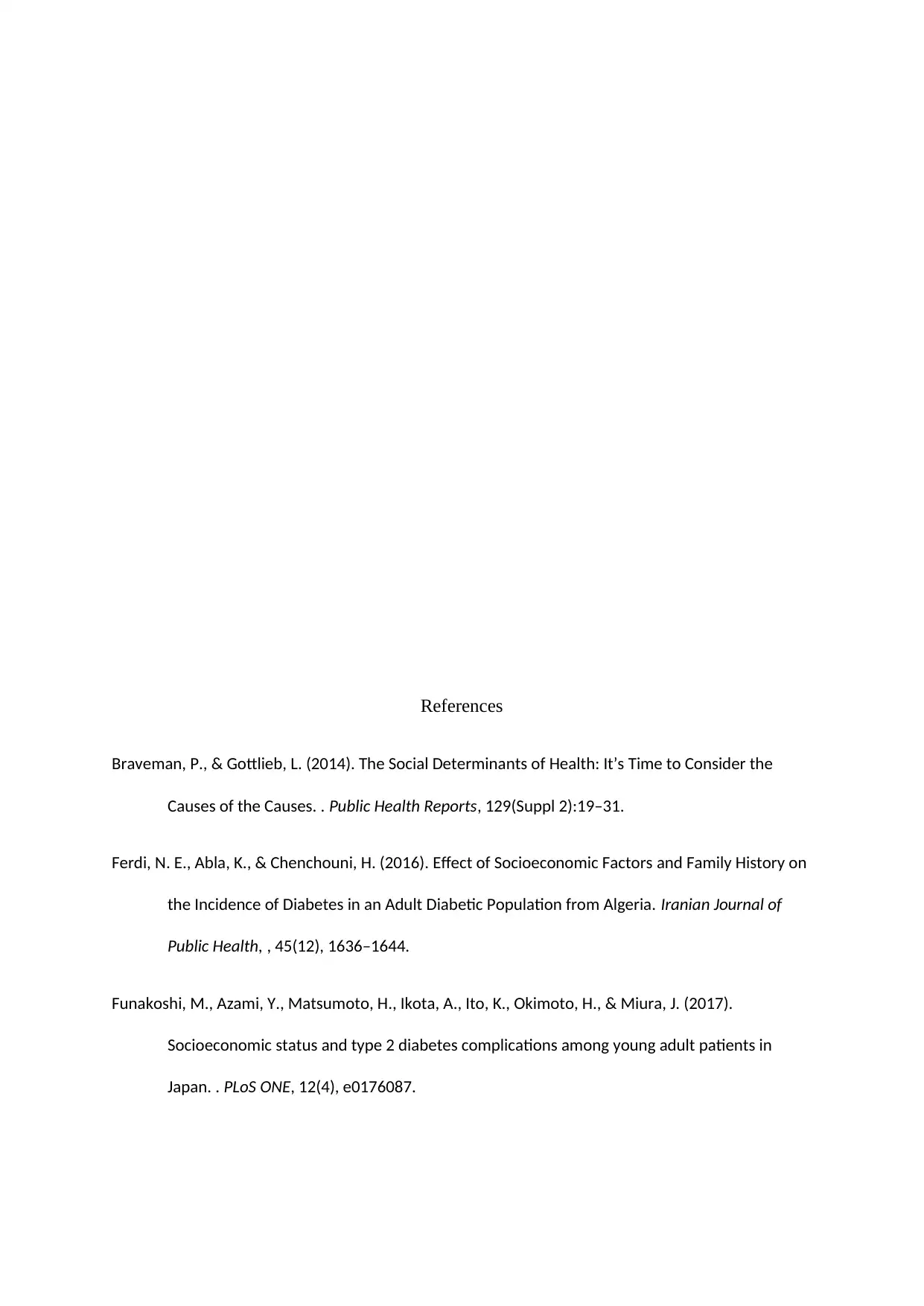
References
Braveman, P., & Gottlieb, L. (2014). The Social Determinants of Health: It’s Time to Consider the
Causes of the Causes. . Public Health Reports, 129(Suppl 2):19–31.
Ferdi, N. E., Abla, K., & Chenchouni, H. (2016). Effect of Socioeconomic Factors and Family History on
the Incidence of Diabetes in an Adult Diabetic Population from Algeria. Iranian Journal of
Public Health, , 45(12), 1636–1644.
Funakoshi, M., Azami, Y., Matsumoto, H., Ikota, A., Ito, K., Okimoto, H., & Miura, J. (2017).
Socioeconomic status and type 2 diabetes complications among young adult patients in
Japan. . PLoS ONE, 12(4), e0176087.
Braveman, P., & Gottlieb, L. (2014). The Social Determinants of Health: It’s Time to Consider the
Causes of the Causes. . Public Health Reports, 129(Suppl 2):19–31.
Ferdi, N. E., Abla, K., & Chenchouni, H. (2016). Effect of Socioeconomic Factors and Family History on
the Incidence of Diabetes in an Adult Diabetic Population from Algeria. Iranian Journal of
Public Health, , 45(12), 1636–1644.
Funakoshi, M., Azami, Y., Matsumoto, H., Ikota, A., Ito, K., Okimoto, H., & Miura, J. (2017).
Socioeconomic status and type 2 diabetes complications among young adult patients in
Japan. . PLoS ONE, 12(4), e0176087.
Paraphrase This Document
Need a fresh take? Get an instant paraphrase of this document with our AI Paraphraser
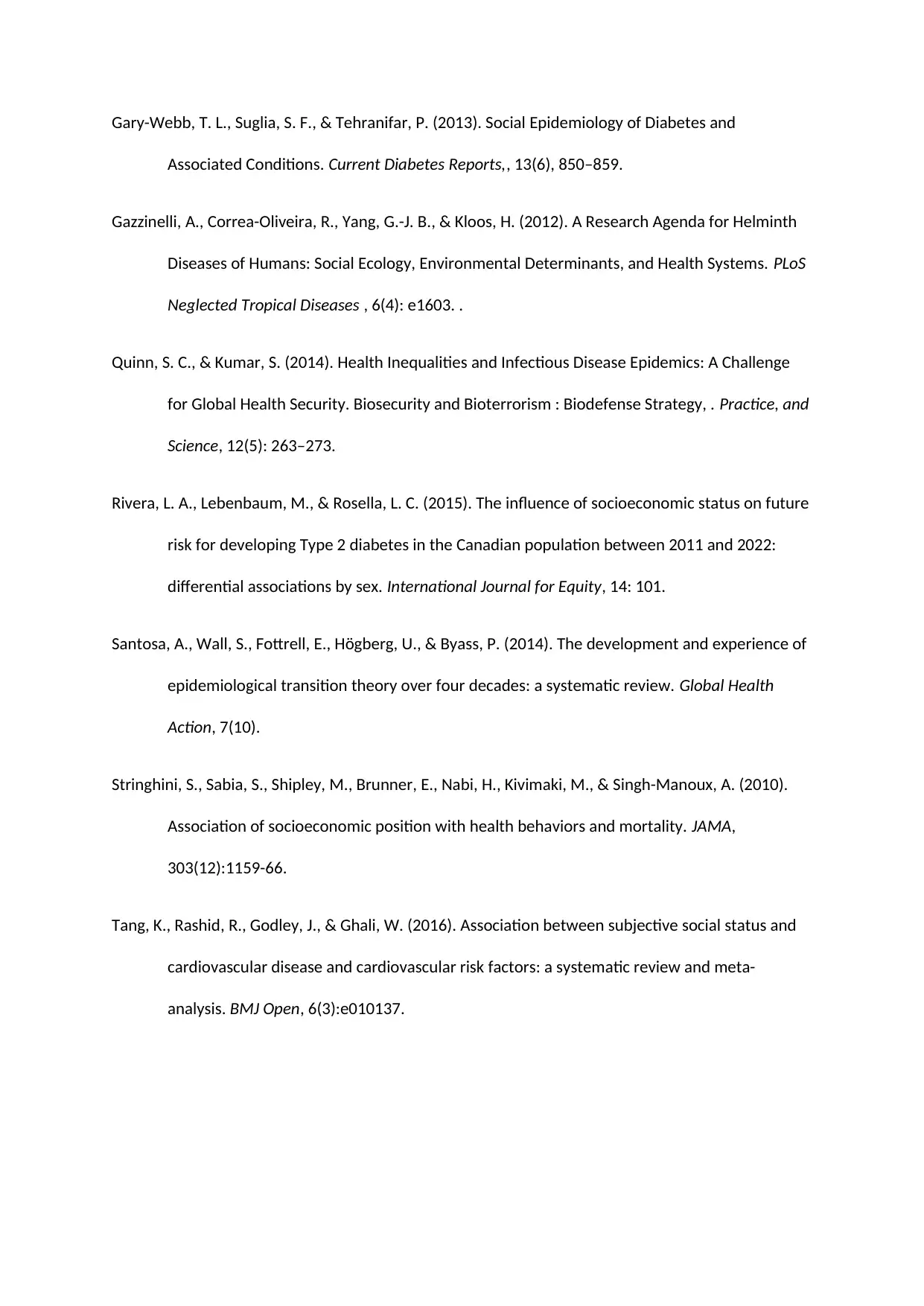
Gary-Webb, T. L., Suglia, S. F., & Tehranifar, P. (2013). Social Epidemiology of Diabetes and
Associated Conditions. Current Diabetes Reports,, 13(6), 850–859.
Gazzinelli, A., Correa-Oliveira, R., Yang, G.-J. B., & Kloos, H. (2012). A Research Agenda for Helminth
Diseases of Humans: Social Ecology, Environmental Determinants, and Health Systems. PLoS
Neglected Tropical Diseases , 6(4): e1603. .
Quinn, S. C., & Kumar, S. (2014). Health Inequalities and Infectious Disease Epidemics: A Challenge
for Global Health Security. Biosecurity and Bioterrorism : Biodefense Strategy, . Practice, and
Science, 12(5): 263–273.
Rivera, L. A., Lebenbaum, M., & Rosella, L. C. (2015). The influence of socioeconomic status on future
risk for developing Type 2 diabetes in the Canadian population between 2011 and 2022:
differential associations by sex. International Journal for Equity, 14: 101.
Santosa, A., Wall, S., Fottrell, E., Högberg, U., & Byass, P. (2014). The development and experience of
epidemiological transition theory over four decades: a systematic review. Global Health
Action, 7(10).
Stringhini, S., Sabia, S., Shipley, M., Brunner, E., Nabi, H., Kivimaki, M., & Singh-Manoux, A. (2010).
Association of socioeconomic position with health behaviors and mortality. JAMA,
303(12):1159-66.
Tang, K., Rashid, R., Godley, J., & Ghali, W. (2016). Association between subjective social status and
cardiovascular disease and cardiovascular risk factors: a systematic review and meta-
analysis. BMJ Open, 6(3):e010137.
Associated Conditions. Current Diabetes Reports,, 13(6), 850–859.
Gazzinelli, A., Correa-Oliveira, R., Yang, G.-J. B., & Kloos, H. (2012). A Research Agenda for Helminth
Diseases of Humans: Social Ecology, Environmental Determinants, and Health Systems. PLoS
Neglected Tropical Diseases , 6(4): e1603. .
Quinn, S. C., & Kumar, S. (2014). Health Inequalities and Infectious Disease Epidemics: A Challenge
for Global Health Security. Biosecurity and Bioterrorism : Biodefense Strategy, . Practice, and
Science, 12(5): 263–273.
Rivera, L. A., Lebenbaum, M., & Rosella, L. C. (2015). The influence of socioeconomic status on future
risk for developing Type 2 diabetes in the Canadian population between 2011 and 2022:
differential associations by sex. International Journal for Equity, 14: 101.
Santosa, A., Wall, S., Fottrell, E., Högberg, U., & Byass, P. (2014). The development and experience of
epidemiological transition theory over four decades: a systematic review. Global Health
Action, 7(10).
Stringhini, S., Sabia, S., Shipley, M., Brunner, E., Nabi, H., Kivimaki, M., & Singh-Manoux, A. (2010).
Association of socioeconomic position with health behaviors and mortality. JAMA,
303(12):1159-66.
Tang, K., Rashid, R., Godley, J., & Ghali, W. (2016). Association between subjective social status and
cardiovascular disease and cardiovascular risk factors: a systematic review and meta-
analysis. BMJ Open, 6(3):e010137.
1 out of 8
Related Documents
Your All-in-One AI-Powered Toolkit for Academic Success.
+13062052269
info@desklib.com
Available 24*7 on WhatsApp / Email
![[object Object]](/_next/static/media/star-bottom.7253800d.svg)
Unlock your academic potential
Copyright © 2020–2025 A2Z Services. All Rights Reserved. Developed and managed by ZUCOL.





